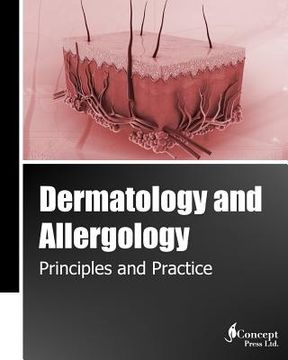Dermatology and Allergology: Principles and Practice (Black and White) (en Inglés)
Reseña del libro "Dermatology and Allergology: Principles and Practice (Black and White) (en Inglés)"
Dermatology is the branch of medicine dealing with the skin and its diseases, a unique specialty with both medical and surgical aspects. Allergology is the study of allergy and hypersensitivity, in which allergy is a hypersensitivity disorder of the immune system and hypersensitivity (also called hypersensitivity reaction or intolerance) refers to undesirable reactions produced by the normal immune system. Dermatology and allergology are two highly interrelated disciplines. Dermatology and Allergology -- Principles and Practice provides some latest research and concerns in these two areas. There are totally 8 chapters in this book. Chapter 1 discusses dermatologic disease with psychiatric manifestations, dermatologic disease influenced by psychosocial stress and psychiatric disorders with cutanous manifestations. Medical Illness with neuropsychiatric and dermatological manifestations and psychiatric side effects of dermatological treatment is also discussed. Chapter 2 describes the ocular surface defence and allergological mechanism when the ocular surface is introduced to foreign bodies, and reviews foreign body reaction caused by synthetic and organic fibers. Chapter 3 discusses podoconiosis, which is a debilitating disease common in several countries across the world. Unfortunately, despite its huge socio-economic and public health burden, podoconiosis has remained neglected in clinical, public health, and policy agendas until quite recently. Chapter 4 evaluates with a second generation antihistamine, like rupatadine, the overall efficacy in the control of morning (AM) and evening (PM) nasal symptoms in patients with allergic rhinitis. This analysis includes the pooled data from five randomized, double blind, placebo-controlled studies. The findings were that overall efficacy (T4SS) relief of symptoms was quite similar for AM or PM period with rupatadine 10 mg once daily, indicating a sustained 24-hour effect of rupatadine irrespective of time of dosing. Chapter 5 proposes to evaluate occupational and environmental risk factors for allergic and hypersensitivity reactions with a public health view. Based on the epidemiological data in developed and developing countries, the authors aim to draw attention to the current status and new ways of understanding allergies and propose solutions for the future. Chapter 6 recites the importance of clinical history for the diagnosis of anaphylaxis, validity of recent investigations/tests in lieu of anaphylaxis and interpretation of various test in the background of clinical history of anaphylaxis. Chapter 7 discusses a common nonscarring, autoimmune disease that can affect any hair-bearing area called Alopecia areata (AA). AA occurs in all ethnic groups, ages, and both sexes and may affect a small area of scalp (patchy type), or involve the entire scalp (alopecia totalis) or whole body (alopecia universalis). Chapter 8 proposes ways of targeting the mycobacterial toxin mycolactone in treatment of Buruli ulcers. Mycolactone plays a central role in ulcer formation by acting on the host at cellular and subcellular levels via several mechanisms.

